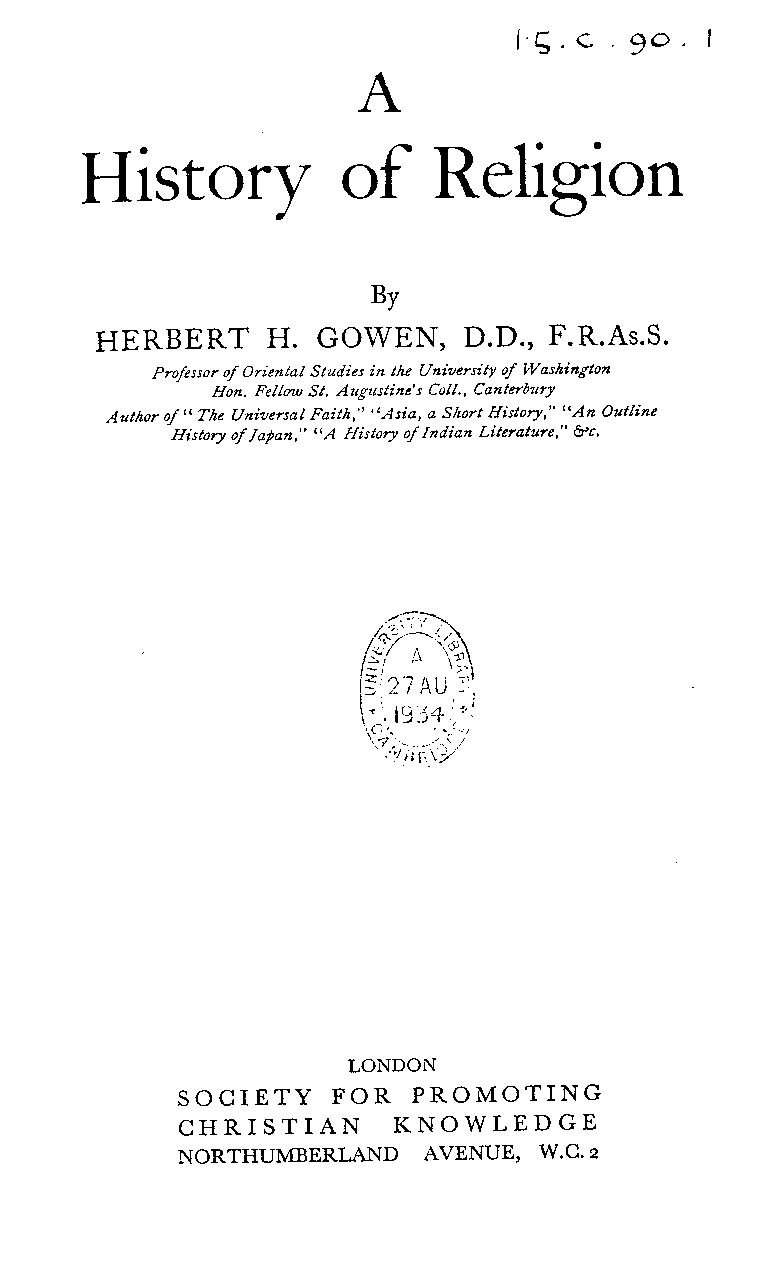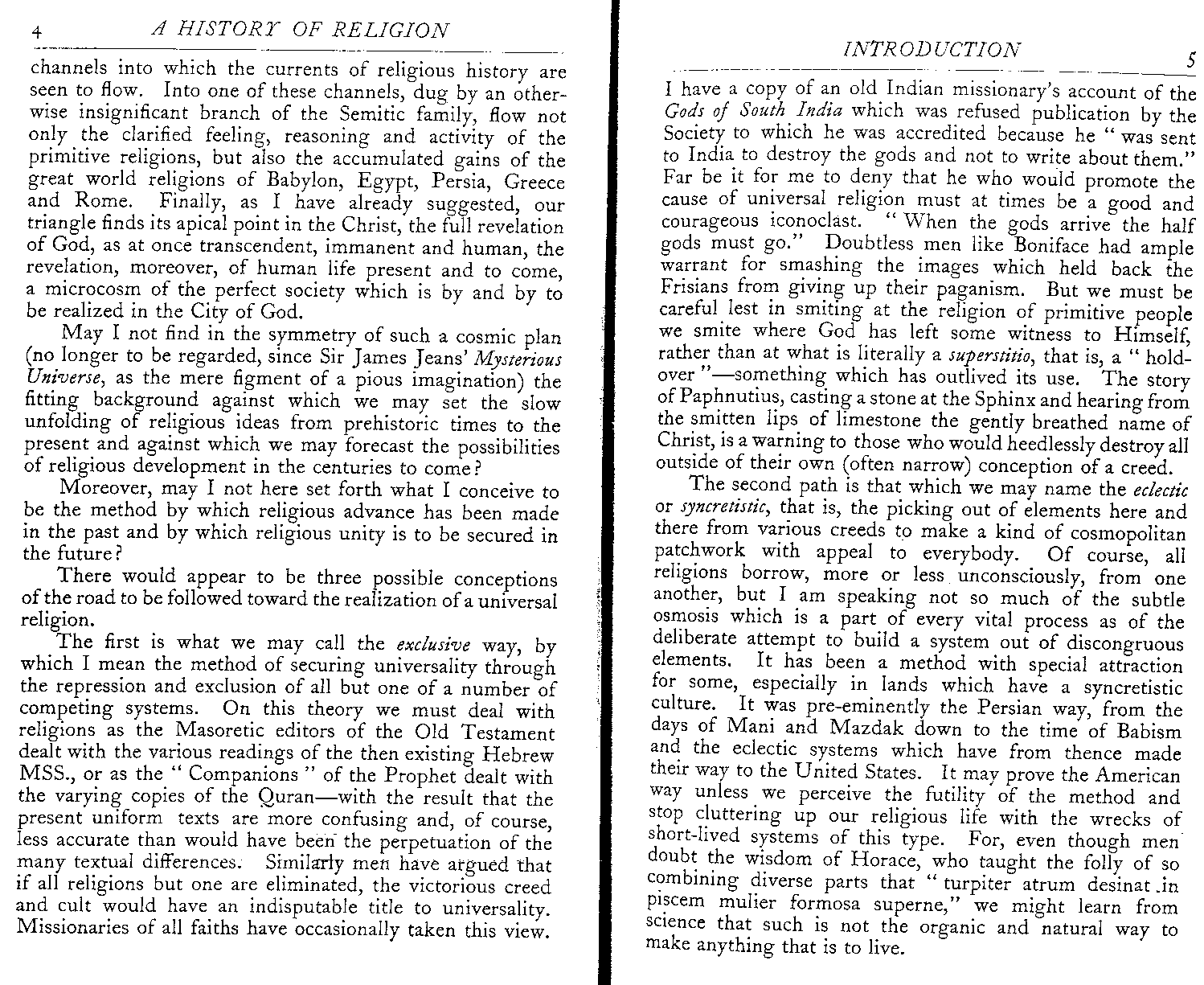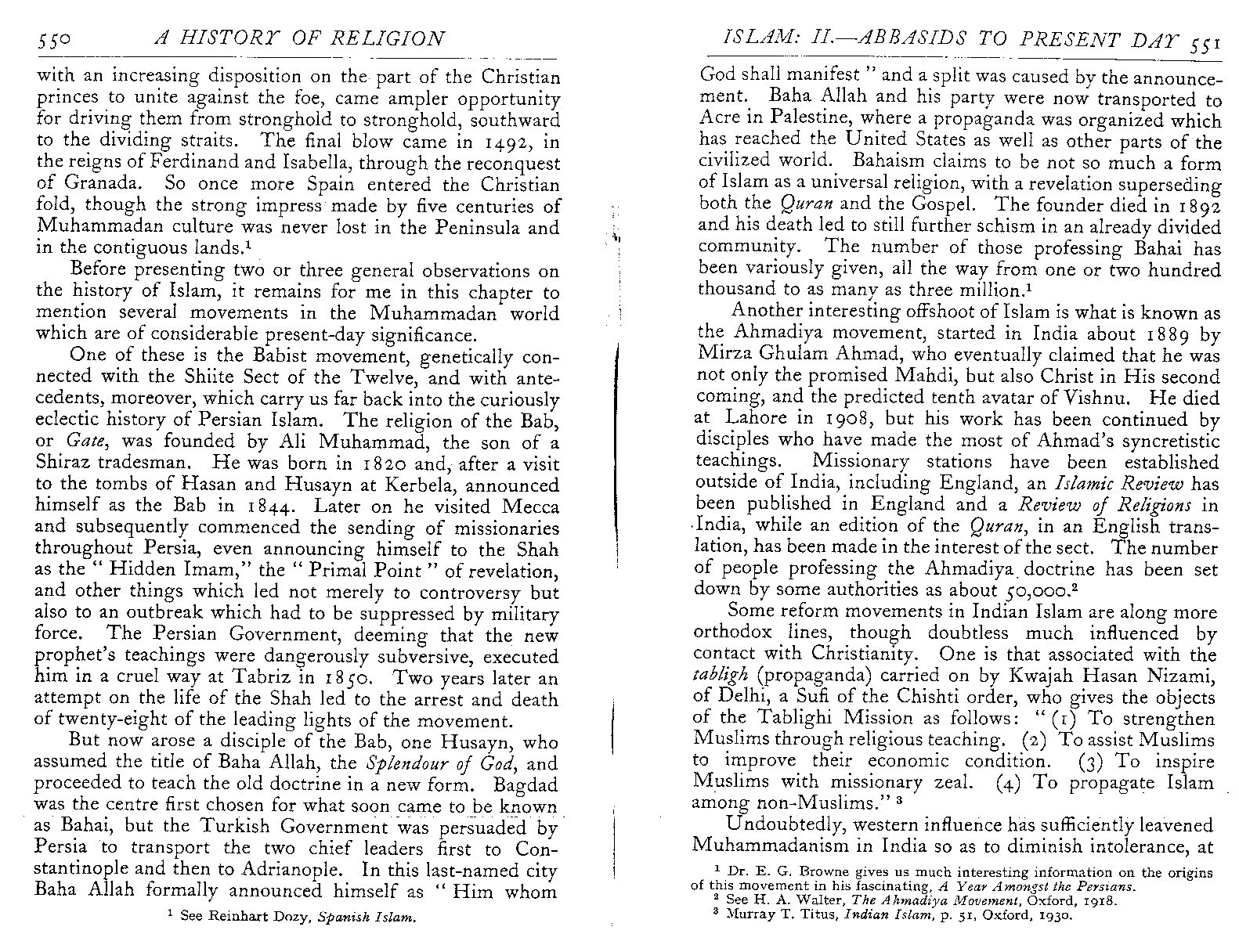
|
|
Abstract: Summary of the Bahá'í Faith as an example of a "syncretistic" religion. Notes: This book is online in a variety of formats at archive.org. |
A History of Religion
by Herbert H. Gowen
pages 4-5, 550-551London: Society for Promoting Christian Knowledge, 1934
1. Text
[pages 4-5]... There would appear to be three possible conceptions of the road to be followed toward the realization of a universal religion.
The first is what we may call the exclusive way, by which I mean the method of securing universality through the repression and exclusion of all but one of a number of competing systems. On this theory we must deal with religions as the Masoretic editors of the Old Testament dealt with the various readings of the then existing Hebrew MSS., or as the "Companions" of the Prophet dealt with the varying copies of the Quran — with the result that the present uniform texts are more confusing and, of course, less accurate than would have been the perpetuation of the many textual differences. Similarly men have argued that if all religions but one are eliminated, the victorious creed and cult would have an indisputable title to universality. Missionaries of all faiths have occasionally taken this view.
I have a copy of an old Indian missionary's account of the Gods of South India which was refused publication by the Society to which he was accredited because he "was sent to India to destroy the gods and not to write about them." Far be it from me to deny that he who would promote the cause of universal religion must at times be a good and courageous iconoclast. "When the gods arrive the half gods must go." Doubtless men like Boniface had ample warrant for smashing the images which held back the Frisians from giving up their paganism. But we must be careful lest in smiting at the religion of primitive people we smite where God has left some witness to Himself, rather than at what is literally a superstitio, that is, a "hold-over" — something which has outlived its use. The story of Paphnutius, casting a stone at the Sphinx and hearing from the smitten lips of limestone the gently breathed name of Christ, is a warning to those who would heedlessly destroy all outside of their own (often narrow) conception of a creed.
The second path is that which we may name the eclectic or syncretistic, that is, the picking out of elements here and there from various creeds to make a kind of cosmopolitan patchwork with appeal to everybody. Of course, all religions borrow, more or less unconsciously, from one another, but I am speaking not so much of the subtle osmosis which is a part of every vital process as of the deliberate attempt to build a system out of discongruous elements. It has been a method with special attraction for some, especially in lands which have a syncretistic culture. It was pre-eminently the Persian way, from the days of Mani and Mazdak down to the time of Babism and the eclectic systems which have from thence made their way to the United States. It may prove the American way unless we perceive the futility of the method and stop cluttering up our religious life with the wrecks of short-lived systems of this type. For, even though men doubt the wisdom of Horace, who taught the folly of so combining diverse parts that "turpiter atrum desinat in piscem mulier formosa superne," we might learn from science that such is not the organic and natural way to make anything that is to live.
[page 550]
... Before presenting two or three general observations on the history of Islam, it remains for me in this chapter to mention several movements in the Muhammadan world which are of considerable present-day significance.
One of these is the Babist movement, genetically connected with the Shiite Sect of the Twelve, and with antecedents, moreover, which carry us far back into the curiously eclectic history of Persian Islam. The religion of the Bab, or Gate, was founded by Ali Muhammad, the son of a Shiraz tradesman. He was born in 1820 and, after a visit to the tombs of Hasan and Husayn at Kerbela, announced himself as the Bab in 1844. Later on he visited Mecca and subsequently commenced the sending of missionaries throughout Persia, even announcing himself to the Shah as the "Hidden Imam," the "Primal Point" of revelation, and other things which led not merely to controversy but also to an outbreak which had to be suppressed by military force. The Persian Government, deeming that the new prophet's teachings were dangerously subversive, executed him in a cruel way at Tabriz in 1850. Two years later an attempt on the life of the Shah led to the arrest and death of twenty-eight of the leading lights of the movement.
But now arose a disciple of the Bab, one Husayn, who assumed the title of Baha Allah, the Splendour of God, and proceeded to teach the old doctrine in a new form. Bagdad was the centre first chosen for what soon came to be known as Bahai, but the Turkish Government was persuaded by Persia to transport the two chief leaders first to Constantinople and then to Adrianople. In this last-named city Baha Allah formally announced himself as "Him whom
[page 551]
God shall manifest" and a split was caused by the announcement. Baha Allah and his party were now transported to Acre in Palestine, where a propaganda was organized which has reached the United States as well as other parts of the civilized world. Bahaism claims to be not so much a form of Islam as a universal religion, with a revelation superseding both the Quran and the Gospel. The founder died in 1892 and his death led to still further schism in an already divided community. The number of those professing Bahai has been variously given, all the way from one or two hundred thousand to as many as three million.1
Another interesting offshoot of Islam is what is known as the Ahmadiya movement, started in India about 1889 by Mirza Ghulam Ahmad, who eventually claimed that he was not only the promised Mahdi, but also Christ in His second coming, and the predicted tenth avatar of Vishnu. He died at Lahore in 1908, but his work has been continued by disciples who have made the most of Ahmad's syncretistic teachings. Missionary stations have been established outside of India, including England, an Islamic Review has been published in England and a Review of Religions in India, while an edition of the Quran, in an English translation, has been made in the interest of the sect. The number of people professing the Ahmadiya doctrine has been set down by some authorities as about 50,000.2
- Dr. E. G. Browne gives us much interesting information on the origins of this movement in his fascinating, A Year Amongst the Persians.
- See H. A. Walter, The Ahmadiya Movement, Oxford, 1918.
2. Image scans (click image for larger version)

|
|


